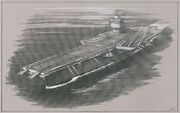AT: "xx"

USS Enterprise (CVN-65), a 20th century aircraft carrier
Two aircraft carriers in San Fransisco Bay in an alternate 1944
An aircraft carrier was a type of naval warship in Earth's 20th and 21st century. Its design and size allowed for aircraft, including fighters, bombers, and helicopters, to be launched and retrieved at sea. It was characterized by a long, flat "flight deck" which served as a mobile air base, condensing apron, landing strip, and runway into a small space. Many aircraft carriers after World War II were powered by nuclear fission.
In an alternate 1944, during World War II, the San Francisco Bay was home to aircraft carriers of the United States Navy. As Shuttlepod 1 flew into the bay, one aircraft carrier was entering the bay, while the other was anchored near Yerba Buena Island. Later, in New York City, Alicia Travers mistook an uniform patch and a subsequent non-committal statement by Jonathan Archer of Enterprise NX-01, as him having served on USS Enterprise (CV-6), which by that time had been sunk in the Pacific Ocean. (ENT: "Storm Front")
When the crew of the destroyed starship USS Enterprise traveled back in time to the year 1986, they collected nuclear radiation from the reactor of USS Enterprise (CNV-65). This enabled them to recrystallize the dilithium of their captured Klingon Bird-of-Prey. (Star Trek IV: The Voyage Home)
By the 22nd century it had become a tradition in Starfleet that its starships honored their historical namesake aircraft carrier predecessors with representations in any of their interiors; Enterprise (CNV-65) was represented as a painting in Captain Archer's ready room aboard Enterprise NX-01, whereas the same vessel was in the 24th century represented as a bass relief in the observation lounge of USS Enterprise-D. (ENT, TNG) In the 23rd century a representation of Enterprise (CV-6) was displayed in a gallery on the recreation deck of the refit-USS Enterprise (NCC-1701). (Star Trek: The Motion Picture)
Background information
The very distinctive profile of the uppermost carrier in the San Fransisco Bay scene in "Storm Front", suggested it was a member of the pre-World War II Yorktown-class to which USS Enterprise (CV-6) had belonged, and after which Gene Roddenberry had named his Star Trek: The Original Series USS Enterprise starship. As she was declared already sunk by Travers, this, historically at least, only left her three class sisters as possible candidates, USS Yorktown (CV-5) – after which Roddenberry had named his starship originally in his 1964 Star Trek is...-pitch – , the scaled down USS Wasp (CV-7) version, or USS Hornet (CV-8, and the penultimate American carrier to be destroyed in the war), all of which by 1944 in actuality already sunk by the Japanese Navy, while Enterprise (having participated in all Pacific campaigns, save for the Battle of the Coral Sea) ironically became the sole class survivor and one of history's most celebrated vessels, much like its fictional starship counterpart. Incidentally, all these carriers were considered by Original Series Producers D.C. Fontana and Robert Justman as namesakes for starships belonging to, what they at the time still called, the Starship-class, USS Yorktown yet introduced into the franchise at a later time in dialog in the second season Original Series episode "Obsession" (though never firmly established in canon as being Constitution-class). The annotations on their memos, made it very clear that the two Star Trek staffers had indeed the WW II carriers, and not other historical vessels, in mind when making the name suggestions. (The Making of Star Trek, pp. 164-165)
Other Constitution-class vessels named after aircraft carriers include,
- USS Lexington – after USS Lexington (CV-2), Lexington-class and USS Lexington (CV-16), Essex-class, the latter being renamed from USS Cabot to honor the former when lost in the Coral Sea.
- USS Intrepid – after USS Intrepid (CV-11), Essex-class.
- USS Constellation – after USS Constellation (CV-64), Kitty Hawk-class.
- USS Eagle – after British carrier HMS Eagle, no class.
USS Essex (after USS Essex (CV-9), class vessel) nearly made the cut as it was already featured in the first draft treatment of the script, dated September 30, 1967 for the second season episode "Journey to Babel", which contained a line having Lieutenant Uhura state,
- "Star Fleet Command confirms alien attack on the other starships, Sir. The enemy was defeated. Starships Essex and Eagle suffered heavy damage, but will make base."
The reference though, was dropped from the episode as aired. [1]
In Star Trek IV, the "part" of USS Enterprise (CNV-65) was actually filled by the conventionally-powered USS Ranger (CV-61, Forrestal-class), because Enterprise was on deployment at the time of the movie's filming. (Star Trek Encyclopedia, 1997, p. 137)
According to Star Trek: Deep Space Nine Technical Manual (page 83), Earth-based aircraft carriers were phased out in 2051.
The shooting script for Star Trek: The Motion Picture described the length of the long range shuttle Surak to USS Enterprise (NCC-1701) as, "about the size of a figher aircraft floating in over the vastness of an aircraft carrier".
